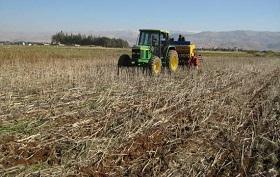From Architecture to AI-Powered Building Diagnostics: Tarek Rakha’s start-up story
10 June 2025
Published online 2 October 2013

A pilot programme to test the benefits of no-till farming has proved the technique can yield good results for smallholder farmers and owners of large tracts of land.
The results debunk the widely-held belief that heavy ploughing of the earth before planting crops is essential to prepare a viable seed bed, regenerate the soil and obtain profitable yields.
The programme that started on a plot of land at the AUB research and educational station in the Bekaa Valley and at the Lebanese Agricultural Research Institute (LARI), was led by Isam Bashour, a specialist in soil science and nutrition at the American University in Beirut (AUB).
Stephen Loss, a senior researcher at ICARDA, who leads a project in Iraq promoting conservation cropping, says that although immediately after heavy ploughing, soils are more porous for better water infiltration and less dense, allowing for strong roots – the positive effect declines within weeks. Soil which is not ploughed develops better soil structure and has increased organic matter.
Conservation agriculture hinges on three concepts: minimum disturbance of the soil, preserving soil cover and rotation of crops. Adhering to these principles improves fertility and eliminates the costs and labour demanded by ploughing.
The initial experiment at the AUB station yielded good results, but confirmation came through testing on farmers' land, according to Bashour. The researchers divided plots in half and implemented conservation agriculture principles on one side and conventional techniques on the other. Bashour says the yield was comparable and sometimes better from crops in non-disturbed soil. Factoring in the savings from ploughing costs, farmers saved about US$200 per hectare.
Conventional seeders are not effective in unploughed soil so sowing is performed by zero-tillage (ZT) seeders, machines equipped with narrow points that cut slits in the soil to minimize disturbance, while delivering seeds and fertilizer. The outlay for these imported machines can be too high for farmers, but the AUB and LARI rent them to local land-owners for an affordable fee..
ICARDA has been promoting conservation agriculture in Iraq and Syria for more than a decade and to increase adoption of these techniques it has helped local manufacturers convert existing seeder machines into ZT seeders that can be bought at a tenth of the cost of imported ones. Farmers who bought the adapted seeders gave feedback to manufacturers, leading to gradual improvement of the technology, says Loss.
Bashour says the seeders performed poorly in Lebanon because of its clay-heavy soil – as opposed to the lighter soil in Iraq and Syria, making the heavier imported ZT seeders the only option currently available.
Loss says that the no-till technique can be used for most soils in many climates, "from the tropical, sub-humid and Mediterranean-type climates, across all soil types from coarse sands to heavy clays and in acid and alkaline soils." He says it is also effective for desert agriculture.
doi:10.1038/nmiddleeast.2013.169
Stay connected: